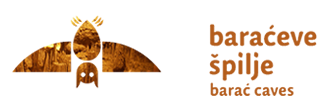Landscape diversity
According to the classification of landscapes from the National Strategy for Protecting Biological and Landscape Diversity, the area of the Protected Landscape of Barać Caves belongs to the landscape unit “Kordun Plateau”. The relief of the protected area today is the consequence of karst processes unfolding over time and the action of the watercourses that remain active today. Streams meander naturally thus making the area more dynamic, which is particularly pronounced in the bed of the stream of Kršlja.

Karst relief predominates, dotted with anthropogenic forms of relief. The most common relief forms are sinkholes of a very high density, which are completely absent in the area of Kršlja Basin. Although the tunnels of nine recorded caves stretch underground, part of the caves also have an effect on the diversity of the landscape. The cave system of Jovo’s Cave – Ponorac is important due to its hydrological function, as it is at Ponorac that the course of the Grabovac stream intermittently dips underground while, after its subterranean course, the stream of Suvaja emerges through Jovo’s Cave. Intermittent and permanent watercourse habitats interchange, and the borders between them sometimes cannot be established with certainty. These watercourses, together with limestone rocks, caves and forests are classified as natural habitats, while grassland and shrubland are defined as semi-natural habitats as they were created through human influence. The most represented habitats within the protected area are forest habitats. Beech forests and mixed hornbeam forests cover nearly half of the area. The forests interchange with shrubland, heaths and grassland, as well as with mosaics of cultivated areas, which contributes to the diversity of the landscape. Grasslands unsuitable for farming and largely used as meadows or pastures today cover a small area, and are developing into shrubland or forestland as the result of mowing and grazing no longer being carried out. Anthropogenic influences, however, were not strong enough to lead to the complete devastation of primary habitats, instead merely contributing to visual diversity.
Landscape diversity is manifested in the natural characteristics of this region and specific anthropogenic influences, as well as in their mutual interaction. The category of protected landscape supports and encourages traditional methods of use with the aim of preserving and protecting natural and semi-natural habitats, the species related to them and other values conditioned by human activity.
Classifying an area as a protected landscape protects its geodiversity and biodiversity and preserves the landscape features typical of this area, which is achieved by using it in a traditional, balanced way.

